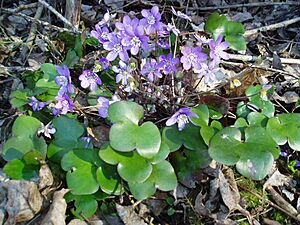Blåsippor facts for kids
Quick facts for kids "Blåsippor" |
|
|---|---|
| Song | |
| Language | Swedish |
| Published | 1894 (as a poem) 1895 (as a song) |
| Genre | children |
| Songwriter(s) | Anna Maria Roos |
| Composer(s) | Alice Tegnér |
Blåsippor is a very popular Swedish children's song. It is often sung in the springtime. The song is also known by its first line, Blåsippan ute i backarna står.
The words for "Blåsippor" were written by Anna Maria Roos. She first published it as a poem in 1894. This poem was part of her book called Lilla Elnas sagor.
A year later, in 1895, Alice Tegnér wrote music for the poem. It then became the song we know today. The song was published in the third volume of the songbook "Sjung med oss, mamma!"
About the Song
"Blåsippor" means "Blue Anemones" in English. These are small blue flowers that bloom early in spring. The song describes these flowers standing in the hills. It talks about how they bravely face the cold weather.
The song is a classic in Swedish children's music. It helps kids learn about nature and the changing seasons. Many generations of children have grown up singing this tune.
Early Recordings
"Blåsippor" has been recorded many times over the years. An early recording was made on June 19, 1947. It featured Sylvan Beré and Knut Edgardt. They recorded it at the Stockholm Concert Hall. This recording was part of a mix of children's songs. It was released on a record later that year in December.
Another recording was made in 1975. This version was sung by Ingela "Pling" Forsman. Her recording was on an album with songs from the "Nu ska vi sjunga" songbook.


